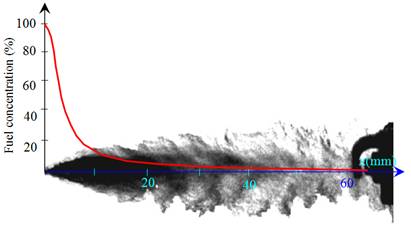LPG Jet Development in Combustion
Chamber of Spark Ignition Engine
GATEC
In the last decade of 20th century, a new kind of spark ignition engines has been developed: the Gasoline Direct Injection (GDI) engine. This kind of engine, particularly the stratified mixture one, is highly attractive thanks to its performance in economic and pollution emission aspects. The mixture fraction is very lean in partial load. Thus, in view of ignition in this case, a good equivalent ratio around the spark plug is needed. This requires an optimal organization of mixture distribution in function of time and space in the combustion chamber of the engine.


Gas direct injection engine will be an ideal one for the purpose. In fact, the engines which operate on natural gas or liquefied petroleum gas (LPG), can satisfy easily the strictest standard of pollution emission actually. So if we can apply gaseous fuel on direct injection spark ignition engine, the advantages will be doubled. Our research is a contribution to develop a gaseous direct injection engine in which LPG in liquid state is used.
The performance of GDI engine strongly depends on mixture formation and combustion in stratified regime. In GDI engine, the rich mixture is obtained around the spark plug so that the ignition can be started. The concentration gradient vs time and about 300ms after injection, the mixture of all fuels is pratically homogene. The influence of evaporation speed on stratified mixture formation is not important. Most of injected fuel is evaporated within the first haft of time from injection to ignition. The proprieties of fuel have no influence on concentration distribution around spark plug even if there is high difference on evaporation character. This observation is very useful for studying LPG direct injection engine because the application of results on GDI engine to this kind of engine is possible.

The present paper introduces some results on distribution of fuel concentrations of LPG jet in the combustion chamber of spark ignition engine given by mesure and calculation. The conserved scalar model is developed for species exchange in turbulent diffusion jet. The integral equations system for convection-diffusion process is closed by turbulence k-emodel.



















